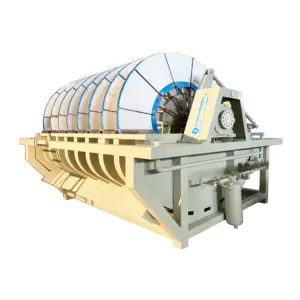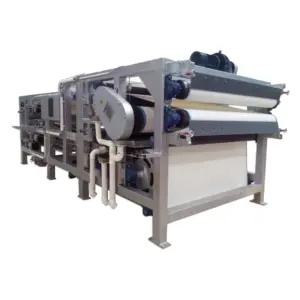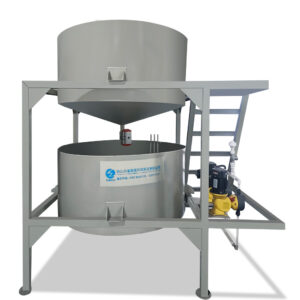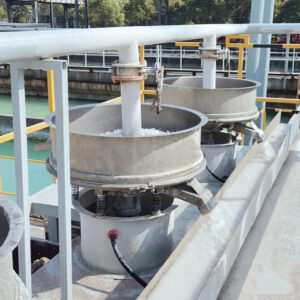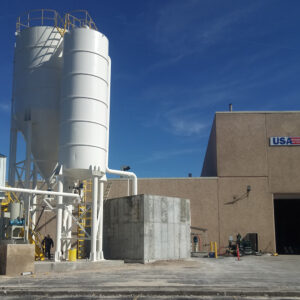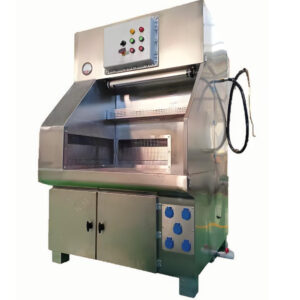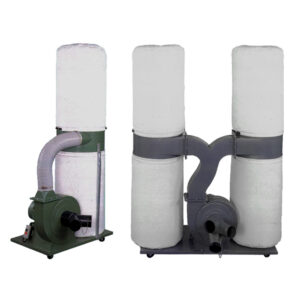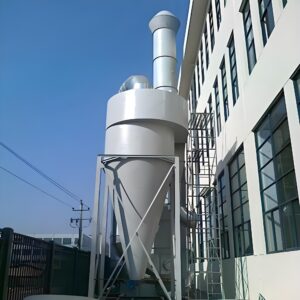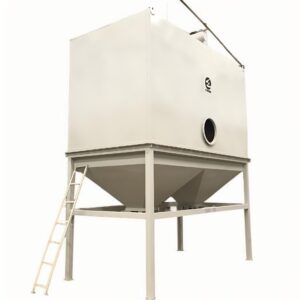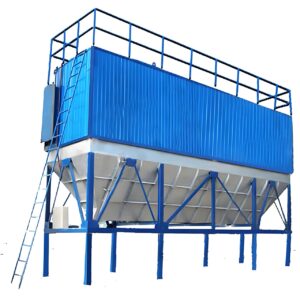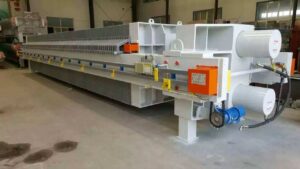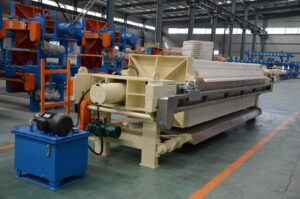Integrating screening and grit removal processes is a critical component of effective wastewater treatment systems. As urban populations grow and industrial activities expand, the need for efficient and reliable methods to remove debris and grit from incoming wastewater has become increasingly important. This article explores the intricacies of combining screening and grit removal processes to enhance overall treatment efficiency and protect downstream equipment.
The integration of screening and grit removal processes offers numerous benefits, including improved water quality, reduced wear on equipment, and enhanced operational efficiency. By removing large particles and inorganic materials early in the treatment process, these combined systems help prevent clogging, reduce maintenance requirements, and extend the lifespan of downstream treatment components.
As we delve deeper into this topic, we'll examine the various technologies and methodologies used in modern screening and grit removal systems, explore their applications in different industries, and discuss the factors that influence their effectiveness. We'll also consider the challenges faced by treatment plant operators and engineers when implementing these integrated processes and explore innovative solutions to overcome these obstacles.
Integrating screening and grit removal processes is essential for optimizing wastewater treatment efficiency and protecting downstream equipment from damage caused by large particles and abrasive materials.
What are the primary objectives of integrating screening and grit removal processes?
The integration of screening and grit removal processes serves multiple crucial objectives in wastewater treatment. These combined systems are designed to efficiently remove a wide range of contaminants from incoming wastewater streams, ensuring that downstream treatment processes can operate more effectively.
The primary goals of integrating these processes include removing large debris, such as rags, plastics, and other solid waste, as well as inorganic particles like sand, gravel, and other abrasive materials. By achieving these objectives, treatment plants can significantly reduce the risk of equipment damage, minimize operational disruptions, and improve overall treatment efficiency.
When properly implemented, integrated screening and grit removal systems can handle varying flow rates and contaminant loads, adapting to the dynamic nature of wastewater streams. This flexibility is particularly important in areas with combined sewer systems or those subject to significant seasonal variations in wastewater composition.
Integrated screening and grit removal processes aim to protect downstream equipment, improve treatment efficiency, and reduce operational costs by removing a wide range of contaminants early in the treatment process.
To illustrate the effectiveness of these integrated systems, consider the following data on contaminant removal rates:
| Contaminant Type | Removal Efficiency |
|---|---|
| Large Debris (>6mm) | 95-99% |
| Sand and Grit (>0.2mm) | 90-95% |
| Floating Oil and Grease | 70-80% |
| Fine Particulates (0.1-0.2mm) | 60-70% |
By achieving these high removal rates early in the treatment process, integrated screening and grit removal systems lay the foundation for more effective biological and chemical treatment in subsequent stages.
How do screening processes contribute to overall wastewater treatment efficiency?
Screening processes play a crucial role in the initial stages of wastewater treatment, serving as the first line of defense against large debris and solid waste. These processes significantly contribute to the overall efficiency of wastewater treatment systems by removing materials that could otherwise cause operational problems or damage downstream equipment.
Screening Processes typically involve the use of bars, meshes, or perforated plates to physically separate larger solids from the liquid waste stream. The effectiveness of these systems depends on factors such as screen opening size, flow rate, and the characteristics of the incoming wastewater.
Modern screening technologies have evolved to include advanced features such as self-cleaning mechanisms, automatic raking systems, and real-time monitoring capabilities. These innovations have greatly improved the reliability and efficiency of screening processes, reducing maintenance requirements and minimizing the risk of system failures.
Effective screening processes can remove up to 30% of the biochemical oxygen demand (BOD) and 35% of the suspended solids from raw wastewater, significantly reducing the load on downstream treatment processes.
To better understand the impact of different screening technologies, consider the following comparison:
| Screening Technology | Typical Opening Size | Removal Efficiency (Solids >6mm) |
|---|---|---|
| Coarse Bar Screens | 6-100mm | 60-80% |
| Fine Screens | 1-6mm | 80-95% |
| Micro Screens | 0.5-1mm | 90-98% |
| Rotary Drum Screens | 0.25-3mm | 85-95% |
By selecting the appropriate screening technology based on the specific characteristics of the incoming wastewater, treatment plant operators can optimize the removal of solids and debris, thereby enhancing the overall efficiency of the treatment process.
What are the key components of an effective grit removal system?
Grit removal is a critical process in wastewater treatment that follows screening and focuses on removing inorganic particles such as sand, gravel, and other abrasive materials. An effective grit removal system is essential for protecting downstream equipment and improving the overall efficiency of the treatment process.
The key components of a grit removal system typically include:
- Grit chambers or tanks
- Flow control structures
- Grit collection mechanisms
- Grit washing and dewatering equipment
- Grit disposal systems
These components work together to create optimal conditions for the separation and removal of grit particles from the wastewater stream. The design and configuration of these components can vary depending on factors such as the expected grit load, flow characteristics, and space constraints.
PORVOO offers advanced grit removal systems that incorporate innovative technologies to enhance performance and reliability. These systems are designed to handle a wide range of flow rates and grit concentrations, making them suitable for various applications in municipal and industrial wastewater treatment.
Properly designed grit removal systems can achieve removal efficiencies of up to 95% for particles larger than 0.2mm, significantly reducing wear on pumps, valves, and other downstream equipment.
To illustrate the performance of different grit removal technologies, consider the following comparison:
| Grit Removal Technology | Typical Removal Efficiency | Hydraulic Retention Time |
|---|---|---|
| Aerated Grit Chambers | 90-95% | 2-5 minutes |
| Vortex-type Grit Chambers | 85-95% | 30-60 seconds |
| Horizontal Flow Grit Chambers | 80-90% | 1-3 minutes |
| Stacked Tray Grit Removal | 95-98% | 1-2 minutes |
By selecting the appropriate grit removal technology and optimizing its operation, treatment plant operators can significantly reduce the impact of abrasive materials on downstream processes and equipment.
How can the integration of screening and grit removal processes be optimized?
Optimizing the integration of screening and grit removal processes requires a holistic approach that considers the unique characteristics of the incoming wastewater, the treatment plant's specific requirements, and the available technologies. By carefully designing and implementing these integrated systems, treatment plant operators can achieve significant improvements in overall treatment efficiency and equipment longevity.
One key aspect of optimization is the proper sequencing of screening and grit removal processes. Typically, coarse screening is performed first to remove large debris, followed by fine screening and then grit removal. This sequence helps protect the grit removal equipment from damage caused by large objects and ensures that the grit removal process can operate more effectively.
Another important consideration is the selection of complementary technologies for screening and grit removal. For example, combining a multi-rake bar screen with a vortex-type grit chamber can provide excellent removal efficiencies for both large debris and fine grit particles while minimizing energy consumption and space requirements.
Integrating advanced control systems and real-time monitoring technologies can improve the performance of combined screening and grit removal processes by up to 25%, leading to significant reductions in operational costs and maintenance requirements.
To illustrate the potential benefits of optimizing integrated screening and grit removal processes, consider the following data:
| Performance Metric | Before Optimization | After Optimization | Improvement |
|---|---|---|---|
| Debris Removal Efficiency | 85% | 95% | +10% |
| Grit Removal Efficiency | 80% | 92% | +12% |
| Energy Consumption | 100 kWh/day | 80 kWh/day | -20% |
| Maintenance Frequency | Monthly | Quarterly | -67% |
By carefully analyzing system performance and implementing targeted improvements, treatment plant operators can achieve significant gains in efficiency and reliability.
What challenges are commonly faced when implementing integrated screening and grit removal systems?
Implementing integrated screening and grit removal systems can present several challenges for wastewater treatment plant operators and engineers. These challenges often stem from the complex nature of wastewater streams, the variability in flow rates and contaminant loads, and the need to balance performance with operational costs.
One common challenge is dealing with the wide range of debris and grit particles present in wastewater. Different types of contaminants may require specific removal techniques, making it difficult to design a single system that effectively addresses all issues. For example, lightweight plastics may float and bypass traditional grit removal systems, while fibrous materials can clog screens and reduce their efficiency.
Another significant challenge is managing the impact of peak flow events, such as those caused by heavy rainfall in combined sewer systems. These events can overwhelm screening and grit removal systems, leading to reduced removal efficiencies and potential damage to downstream equipment.
Integrated screening and grit removal systems must be designed to handle peak flow rates up to 3-4 times the average daily flow while maintaining removal efficiencies of at least 80% for both debris and grit particles.
To better understand the impact of flow variability on system performance, consider the following data:
| Flow Condition | Debris Removal Efficiency | Grit Removal Efficiency |
|---|---|---|
| Average Flow | 95% | 92% |
| Peak Flow (2x Average) | 90% | 85% |
| Peak Flow (3x Average) | 85% | 80% |
| Peak Flow (4x Average) | 75% | 70% |
This data highlights the importance of designing integrated systems that can maintain high removal efficiencies even under challenging flow conditions.
How do advancements in technology impact the efficiency of integrated screening and grit removal processes?
Advancements in technology have significantly impacted the efficiency and effectiveness of integrated screening and grit removal processes in recent years. These innovations have led to improved performance, reduced energy consumption, and enhanced operational flexibility for wastewater treatment plants.
One of the most notable technological advancements is the development of intelligent control systems that can automatically adjust screening and grit removal parameters based on real-time monitoring of flow rates and contaminant loads. These systems use sensors and data analytics to optimize the operation of screens, grit chambers, and associated equipment, ensuring maximum removal efficiencies while minimizing energy consumption.
Another important development is the use of advanced materials and design techniques in screening and grit removal equipment. For example, new screen designs with optimized bar profiles and self-cleaning mechanisms have improved debris capture rates while reducing the risk of clogging. Similarly, innovative grit chamber designs that incorporate computational fluid dynamics (CFD) modeling have enhanced grit removal efficiencies across a wider range of flow conditions.
The implementation of advanced control systems and optimized equipment designs can increase the overall efficiency of integrated screening and grit removal processes by up to 30%, resulting in significant reductions in operational costs and improved treatment outcomes.
To illustrate the impact of these technological advancements, consider the following comparison of traditional and advanced integrated systems:
| Performance Metric | Traditional System | Advanced System | Improvement |
|---|---|---|---|
| Debris Removal Efficiency | 85% | 98% | +13% |
| Grit Removal Efficiency | 80% | 95% | +15% |
| Energy Consumption | 100 kWh/day | 70 kWh/day | -30% |
| Operational Flexibility | Limited | High | Significant |
| Maintenance Requirements | High | Low | Reduced |
These advancements demonstrate the potential for significant improvements in the performance and efficiency of integrated screening and grit removal processes through the adoption of new technologies.
What are the environmental benefits of implementing effective screening and grit removal processes?
Implementing effective screening and grit removal processes as part of an integrated wastewater treatment system offers numerous environmental benefits. These processes play a crucial role in protecting water resources, reducing pollution, and promoting sustainable water management practices.
One of the primary environmental benefits is the reduction of pollutants entering natural water bodies. By removing large debris, suspended solids, and inorganic particles early in the treatment process, screening and grit removal systems significantly decrease the amount of harmful materials that could potentially be discharged into rivers, lakes, and oceans. This helps maintain the ecological balance of aquatic ecosystems and protects wildlife from the adverse effects of pollution.
Additionally, effective screening and grit removal processes contribute to energy conservation and reduced greenhouse gas emissions. By removing debris and grit early in the treatment process, these systems reduce the load on downstream treatment stages, which typically require more energy-intensive processes such as aeration and chemical treatment. This results in lower overall energy consumption and a smaller carbon footprint for the treatment plant.
Properly implemented screening and grit removal processes can reduce the energy consumption of downstream treatment processes by up to 20%, contributing to a significant reduction in the overall carbon footprint of wastewater treatment facilities.
To better understand the environmental impact of effective screening and grit removal, consider the following data:
| Environmental Metric | Without Effective Screening/Grit Removal | With Effective Screening/Grit Removal | Improvement |
|---|---|---|---|
| Pollutant Discharge (kg/day) | 1000 | 200 | -80% |
| Energy Consumption (kWh/m³) | 0.5 | 0.4 | -20% |
| CO₂ Emissions (tons/year) | 1000 | 800 | -20% |
| Aquatic Ecosystem Health Score | 6/10 | 8/10 | +33% |
These improvements demonstrate the significant positive impact that effective screening and grit removal processes can have on the environment and overall sustainability of wastewater treatment operations.
How do integrated screening and grit removal systems contribute to long-term cost savings in wastewater treatment plants?
Integrated screening and grit removal systems play a crucial role in achieving long-term cost savings for wastewater treatment plants. By effectively removing debris and abrasive particles early in the treatment process, these systems help protect downstream equipment, reduce maintenance requirements, and improve overall operational efficiency.
One of the primary ways integrated systems contribute to cost savings is by extending the lifespan of downstream equipment. By removing large debris and grit particles, these systems significantly reduce wear and tear on pumps, valves, and other sensitive components. This results in fewer equipment failures, less frequent replacements, and lower overall maintenance costs.
Additionally, effective screening and grit removal processes can lead to reduced chemical usage in subsequent treatment stages. By removing a significant portion of organic and inorganic contaminants, these systems decrease the load on biological and chemical treatment processes, potentially reducing the amount of chemicals required for effective treatment.
Implementing integrated screening and grit removal systems can result in a 30-40% reduction in maintenance costs and a 15-20% decrease in chemical usage, leading to substantial long-term savings for wastewater treatment plants.
To illustrate the potential cost savings associated with integrated screening and grit removal systems, consider the following data:
| Cost Category | Without Integrated System | With Integrated System | Annual Savings |
|---|---|---|---|
| Equipment Maintenance | $500,000 | $350,000 | $150,000 |
| Chemical Usage | $200,000 | $160,000 | $40,000 |
| Energy Consumption | $300,000 | $240,000 | $60,000 |
| Labor Costs | $400,000 | $320,000 | $80,000 |
| Total Annual Savings | – | – | $330,000 |
These figures demonstrate the significant financial benefits that can be realized through the implementation of effective integrated screening and grit removal systems.
In conclusion, the integration of screening and grit removal processes is a critical aspect of modern wastewater treatment systems. By effectively removing large debris, suspended solids, and abrasive particles early in the treatment process, these integrated systems provide numerous benefits, including improved treatment efficiency, reduced equipment wear, lower operational costs, and enhanced environmental protection.
As we've explored throughout this article, the success of integrated screening and grit removal systems depends on careful design, proper technology selection, and ongoing optimization. By leveraging advanced technologies, such as intelligent control systems and innovative equipment designs, treatment plant operators can achieve significant improvements in removal efficiencies, energy consumption, and overall performance.
The environmental benefits of effective screening and grit removal processes cannot be overstated. By reducing pollutant discharge, conserving energy, and protecting aquatic ecosystems, these systems play a crucial role in promoting sustainable water management practices and safeguarding our natural resources for future generations.
Furthermore, the long-term cost savings associated with integrated screening and grit removal systems make them an attractive investment for wastewater treatment facilities. By reducing maintenance requirements, extending equipment lifespans, and improving overall operational efficiency, these systems can deliver substantial financial benefits over time.
As urban populations continue to grow and environmental regulations become increasingly stringent, the importance of effective screening and grit removal processes will only continue to increase. By embracing innovation and best practices in this field, wastewater treatment plants can ensure they are well-equipped to meet the challenges of the future while providing clean, safe water for their communities.
External Resources
What is the recruitment screening process? And how to do it – Indeed – This article explains the recruitment screening process, including the various stages such as reviewing CVs and cover letters, telephone interviews, and formal interviews. It highlights how these processes help identify suitable candidates for a role and ensure they fit well with the company.
10 Frequently Asked Screening Questions for Product Market Research – Metaforms.ai – This resource provides insights into crafting effective screening questions for market research surveys. It covers criteria such as aligning questions with research objectives, focusing on industry sector and job role for B2B research, and assessing prior usage for product testing.
Best Practices When Screening for Market Research Respondents – Civicommrs – This article outlines best practices for screening participants in market research, including establishing strategic screening criteria, avoiding overly restrictive benchmarks, and ensuring flexibility in the screening process.
Screening – (Intro to Psychology) – Fiveable – This definition explains screening in the context of job selection, involving the systematic collection and analysis of information to identify candidates with the necessary qualifications, skills, and characteristics for a specific job or position.
Screening Process in Recruitment: A Step-by-Step Guide – LinkedIn – This resource provides a detailed step-by-step guide on the screening process in recruitment, including initial application reviews, phone or video interviews, and final in-person interviews.
How to Conduct Effective Candidate Screening – Glassdoor – This resource offers tips and strategies for conducting effective candidate screening, including how to create effective screening questions, the importance of background checks, and how to evaluate candidate fit.
